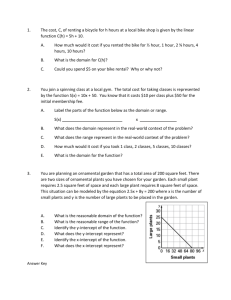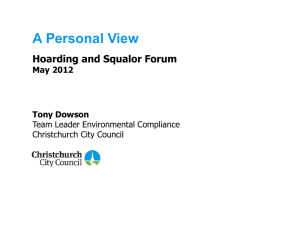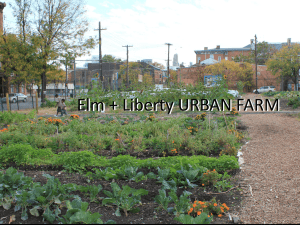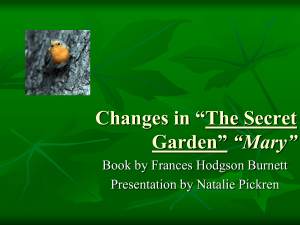Abstracts from garden forum - The St Albans Community Website
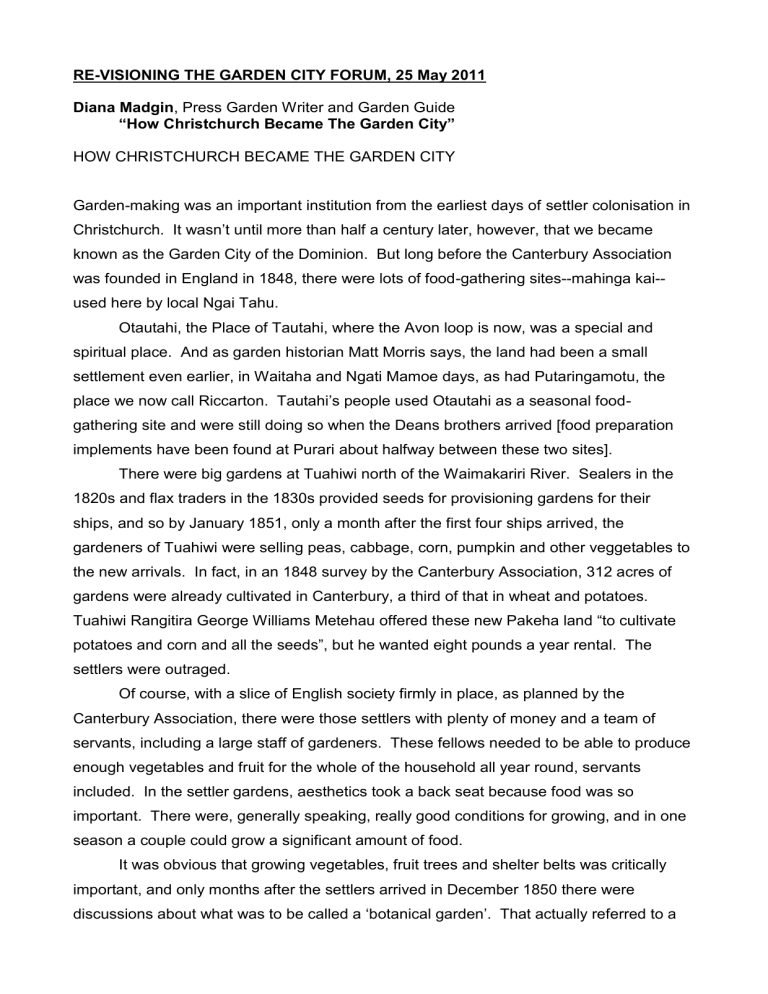
RE-VISIONING THE GARDEN CITY FORUM, 25 May 2011
Diana Madgin , Press Garden Writer and Garden Guide
“How Christchurch Became The Garden City”
HOW CHRISTCHURCH BECAME THE GARDEN CITY
Garden-making was an important institution from the earliest days of settler colonisation in
Christchurch. It wasn’t until more than half a century later, however, that we became known as the Garden City of the Dominion. But long before the Canterbury Association was founded in England in 1848, there were lots of food-gathering sites--mahinga kai-used here by local Ngai Tahu.
Otautahi, the Place of Tautahi, where the Avon loop is now, was a special and spiritual place. And as garden historian Matt Morris says, the land had been a small settlement even earlier, in Waitaha and Ngati Mamoe days, as had Putaringamotu, the place we now call Riccarton. Tautahi’s people used Otautahi as a seasonal foodgathering site and were still doing so when the Deans brothers arrived [food preparation implements have been found at Purari about halfway between these two sites].
There were big gardens at Tuahiwi north of the Waimakariri River. Sealers in the
1820s and flax traders in the 1830s provided seeds for provisioning gardens for their ships, and so by January 1851, only a month after the first four ships arrived, the gardeners of Tuahiwi were selling peas, cabbage, corn, pumpkin and other veggetables to the new arrivals. In fact, in an 1848 survey by the Canterbury Association, 312 acres of gardens were already cultivated in Canterbury, a third of that in wheat and potatoes.
Tuahiwi Rangitira George Williams Metehau offered these new Pakeha land “to cultivate potatoes and corn and all the seeds”, but he wanted eight pounds a year rental. The settlers were outraged.
Of course, with a slice of English society firmly in place, as planned by the
Canterbury Association, there were those settlers with plenty of money and a team of servants, including a large staff of gardeners. These fellows needed to be able to produce enough vegetables and fruit for the whole of the household all year round, servants included. In the settler gardens, aesthetics took a back seat because food was so important. There were, generally speaking, really good conditions for growing, and in one season a couple could grow a significant amount of food.
It was obvious that growing vegetables, fruit trees and shelter belts was critically important, and only months after the settlers arrived in December 1850 there were discussions about what was to be called a ‘botanical garden’. That actually referred to a
plant nursery for the settlers, and a fellow nick-named Cabbage Wilson was the first plant nurseryman here in Christchurch. We know that his nursery was located at Otautahi. (On the commemorative first edition of the Press today, his advertisements can be seen on the back page.)
By February 1851--only two months after the first four ships--a Botanical Society was established and seeking permission to use part of the nursery to plant seeds and cuttings brought by settlers, in order to keep the plants alive after their long ocean voyage.
And by 1857, Mr Wilson was the richest man in Christchurch. He then became a city councillor, and in 1868, just as he was asked to vacate his land so it could be sold to def ray Canterbury Association debts, he became the city’s first mayor.
In 1852 the Botanical Society changed its name to Christchurch Agricultural,
Botanical and Horticultural Society. Robert John Godley was its president and W G
Brittan, treasurer.
Right from the start of settlement, there was vibrant interest from the professional gardeners in having garden shows to display their best fruit and vegetables. These were men who had worked in that competition tradition in Britain, and they were right behind the formation of the new Christchurch Horticultural Society in December 1861.
The first exhibition was held in two tents in Cathedral Square, where the Godley statue is now, although most ignominiously flung, and 2000 visitors came on a beautiful
Boxing Day. These shows were the beginning of a strong and consistent horticultural tradition, which eventually in the 20th century included affiliated garden clubs throughout the city and province. We have lots of their members here tonight--that you for coming.
By the late 1870s there was growing concern amongst our city fathers that
Christchurch was a swampy, dirty, ugly mess. Waste from factories was dumped in the rivers, there were no footpaths, the roads were lousy, and everywhere there was the smell of animal excrement, especially horse. Market Square was the city centre; it was muddy from horses and smelly from horse poo. Shingle for the new roads was dumped there.
To celebrate 50 years of settlement, the fine bronze commemorative statue of
Queen Victoria we have today was then pictured surrounded by fences plastered with obtrusive advertising. These hordings were a particular bone of contention for Samuel
HurstSeagar, who was the city’s most prominent architect, progressive town-planner and conservationist. Like many public figures of the time, Hurst-Seagar was influenced by both the American City Beautiful movement and, more particularly, by Ebenezer Howard’s
English Garden City philosophy, which espoused enlightened urban design, clean cities with good amenities for all levels of society. Hurst-Seagar was elected to the Christchurch
Beautifying Association’s executive at its inaugural meeting in 1897, as were many of the city’s up and coming professional gents.
In fact, the Beautifying Association was to become the driving force for promotion of the title, “Christchurch, the Garden City”. Its immediate objective was to save the last remaining patches of native bush close to the city and to beautify the city’s reserves. It began with what would become the iconic Avon River at its centre. Generally speaking, the public had little interest in native flora at that time, believing that a love of flowers had a refining effect on character.
The first president of the Beautifying Association was Mayor Charles Louisson, and that connection with city government established the Association’s participation in city affairs, like the Duke and Duchess of Cornwall’s visit in 1901 and the completion of the cathedral in 1904 and the move of the city centre to Cathedral Square.
Leonard Cockayne, the Association’s first secretary, introduced the concept of garden competitions. Surprisingly, he felt they could demonstrate to residents the importance of local native species, which was his passion, of course. He was supported by both Harry Ell of Port Hills fame, and Samuel Barker, who was a keen amateur botanist and established a garden of native species on the north bank of the Avon River between
Madras and Manchester Streets. There’s a remnant of his planting there today.
The title “Garden City” has been around for more than a century. It was coined originally by Sir John Gorst, a special commissioner from England at the 1906
International Exhibition. He was a keen disciple of Ebenezer Howard’s Garden City philosophy, and he remarked then that Christchurch was a garden. In 1914, Mayor Henry
Holland addressed the Beautifying Association, urging them to work until there was no doubt that Christchurch was a garden city.
It didn’t happen immediately. In the 1920s and 30s there was increasing concern about the deterioration of the nation’s health. Too many men were rejected for military service, we had high infant mortality rates, over-crowded and sub-standard housing. New ideas on health, sanitation and nutrition emerged and were endlessly debated. Out of all this, modern city planning adopted the suburb, considered the ideal environment for the nuclear family, which would uplift the moral fibre of the nation.
In the 1930s, state housing allocated large sections for garden and play, and boys learned vegetable gardening at school in the expectation that they would become the providers for their families. Plunket’s Sir Truby King was constantly outspoken in his belief that fresh air and sunlight were the vital keys to the nation’s health. Businesses and
factories were encouraged to improve their landscapes for the health and wellbeing of their workers and to enhance the district.
By this time, the Beautifying Association had set up competitions for the best street frontages, not just for private homes, but for whole streets, factories, hotels, hospitals. The
Horticultural Society complemented this institution by setting up different classes for the best all-round gardens. It wanted to see excellence in gardening skills, including, importantly, food for the family in fruit and vegetable gardens. The suburban style espoused neat paths, velvet lawns and bright, colourful beds of flowers.
By the 1960s, when aeroplanes whizzed visitors to Christchurch, the pilot announced their arrival at the Garden City, and the name was here for good.
In the early 1990s, New Zealand was a tourist destination for Japan. I guided large groups of Japanese visitors on full-day tours of prize-winning gardens filled with bright annuals. Journalists from Japan’s glossy women’s magazines wanted to know the story of the Garden City and the institutions that supported it. They wanted garden competitions, too. Since then, competition gardening has receded, and vegetable gardens and allotments have taken off. More school kids are learning about sustainability. Garden tours now include a wide range of outstanding gardens in many styles.
Our Garden City has suffered a shocking attack from quaking earth. But unlike our
Neo-Gothic architecture, most of our heritage trees are still upright. And most of us are, too, thankfully.
So, it looks like the Garden City is off on its next phase.
Dr John Clemens , Curator of Christchurch Botanic Garden
“Christchurch and the Shape of Water: A Tale of Two Botanic Gardens"
Christchurch the Garden City was born of a natural ‘garden’, made possible by an enlightened garden city plan, and brought to life by energetic people who delighted in growing exotic plants from all over the world as well as conserving the indigenous vegetation and plants. The Garden City has been strongly shaped by water: the braided rivers, the shifting coastline, the less than ideal building platform, and the peaceful, meandering Avon. Within its loop of the Avon, the Christchurch Botanic Garden has sheltered and displayed both the exotic and the indigenous for almost 150 years
– ‘two botanic gardens’ – and both complement each other in maintaining the Garden City’s identity.
We already have natural areas in regional parks as well as collections of exotic plants in public gardens and parks. Some of these can be better linked and developed for residents and visitors, and could be enhanced with satellite collections of plants that might be grown more successfully than in the parent Christchurch Botanic Gardens.
The Central City and suburbs are damaged. By acknowledging the intrinsic natural values of the Avon (and other natural features) as well as by enhancing the exotic in the
more urban open spaces of the City we can help heal that damage and ensure we have a stronger Garden City identity into the foreseeable future.
Grant MacLeod , Christchurch City Council, New Zealand Recreation Association
Executive Board
“Natural Play for All, Play Areas for Children"
Play is seen as a means of social development, it helps children interact with each other and explore their own physical capabilities. Christchurch City Council aids in this development by providing playground equipment and open space in neighbourhood and regional settings. Children are naturally inquisitive and need to explore in order to learn.
Play involves the entire setting that the play equipment sits within, not just the structured equipment. Children and adults will make use of areas outside the play equipment. This allows for creative minds to explore.
Creative minds are encouraged when given the chance to explore, we are now in an age when young people do not automatically see parks as a place to recreate actively.
Where youth used to go to explore, is now seen as potential areas for devious behaviour.
Youths themselves are often seen as potentially illegitimate users of open space. By providing quality recreational space, the Council and the Community stand a better chance of allowing youth (and adults) to be constructive and entertained in positive situations.
Play grounds offer the opportunity for children and guardians to bond and socialise with each other. Guardians can be seen as a mechanism for play, thus strengthening bonds and trust. A Guardian’s role in playgrounds is to play (as a part of the apparatus), demonstrate and in many cases provide trust (like a training wheel on a bicycle).
It is important therefore that playgrounds and settings developed for play encourage the adult to be comfortable. The use of gardens in play allows for this.
Peggy Kelly , Packe Street Community Park
“The Growing Need for Community Parks and Gardens in the City”
“Come away, O human child!
To the waters and the wild
With a faery, hand in hand,
For the world’s more full of weeping than you can understand.”
W.B. Yeats
Wildish places are good for us but public wilderness is an increasingly scarce resource in our cities, where land is generally allocated for a designated purpose or fenced off while not in use.
Until the quakes children's access to wilderness was becoming increasingly rare in our inner suburbs where the traditional back-yard is fast disappearing.
Children exercise imagination, leadership, co-operation, creativity and inventiveness when they play together in wilderness; these magical untamed places
(which don’t have to be very large) are put to ever-changing uses; this can sometimes make the authorities a bit nervous.
Beyond maintaining them as "benign areas" adults should however leave these spaces and places alone. Their use by the children should be respected.
Our experience in Packe Street is that children generally move on from using such a place around age 9 - though older child-minding siblings may linger a bit longer.
Communities need to support their local safe wilderness for it to work. Community
Gardens on Council Reserve land can easily incorporate safe wilderness.
An intensifying city needs pocket parks, community gardens and affordable allotments in every neighbourhood
– this was a growing need even before the quakes
To achieve this might mean, for example, that a local community is allowed to convert an unused corner of a large metropolitan sports field into a place that they can call their own
– fill it with fruit trees, individual allotments or whatever meets their needs. There is no template for a community garden.
Making it Happen: Bring back the Parks and Recreation Sub-Committee
When a group of Packe Street residents set out in 1996 to secure land for a pocket-park – land that the children had already discovered as a wonderful overgrown wilderness
– the grown-ups found that there was, in those days, a transparent procedure to follow:
1. Locals gain support form the Residents’ Association
2. Locals and Residents’ Association gain the support of the Community Board
3. Locals and Community Board gain the support of the Parks and Recreation Committee
4. Parks and Recreation Committee put the proposal to Council at a meeting open to the public.
Thus should the process be thwarted at any stage (as it almost was for Packe St
Park by opposition from a particular party) residents could see where and hear why the stumbling block has occurred and work to overcome it.
This rigour and transparency allowed an innovative proposal, backed by local commitment, through the system.
Reinvigorate “Adopt-a-Park”. Communities and Council working together create more interesting and varied neighbourhood gardens than the Council could ever achieve on its own. The Adopt-a-Park scheme formalises the relationship between Council and
Community. Fifteen years on, it still works for Packe St Park/Community Garden.
Neiel Drain , Former Director Parks and Recreation, Christchurch City Council, Former
President Canterbury Horticultural Society
“Christchurch, Garden City of the World. Dream or Reality?”
In 1997, Christchurch entered a newly established international competition,
“Nations in Bloom”, developed by the International Federation of Park and Recreation
Administration (IFPRA). The aim of the competition was to recognise and encourage excellence in the management of the urban landscape by municipalities, in the areas of landscape enhancement, heritage management, environmentally sensitive practices, community involvement and planning for the future; these forming the criteria by which each municipality would be judged.
An initial submission submitted some months prior the event saw Christchurch accepted as a finalist. From a total of 21 finalists Christchurch was named overall winner in the premier (large city) category thus claiming the title for that year, ‘Best Garden City in the World’.
Since the establishment of this award the concept of ‘garden cities’ or ‘greening of cit ies’ has become increasingly fashionable, driven in large part by serious environmental, social and health problems and concerns to maximise business and tourism opportunities.
As a consequence I believe it important to more clearly identify what we mean by the term ‘garden city’. One modern definition is “an integrated city-wide approach to the care, planting and management of all vegetation in a city to secure multiple environmental, economic, social and health benefits for the urban dweller”.
With this in mind, there is opportunity to develop and articulate a new vision of
Christchurch as a garden city based on the above mentioned values consistent with
available resources; drawing also on local knowledge and experience. Among the many ideas available and recently promoted, I offer the following for consideration.
1. Supplementing the many reports and proposals to advance Christchurch’s rebuilding, I would like to see a series of large scale landscape type plans portraying entire city/suburban areas incorporating existing green space and other features, current perceived deficiencies, together with a range of new development proposals, displayed in city malls and libraries for public viewing and input; supported also with photographs and the use of electronic media, with all being updated on a regular basis.
2. For the central city/business area, and long before the events of February and
September last, I have considered and raised with others the desirability of a master plan as a means to achieving more coordinated development, in particular the provision of a quality landscape imprint across the entire central area. Obviously, recent events have imposed huge change, but irrespective of what is done in the future, cognisance needs to be taken of the lack of green space including trees and other vegetation in the southern portion of the central city especially, and the impact of this on the city’s garden image.
3. While Christchurch has long been noted for its extensive and diverse range of public parks and gardens, a matter that should be of concern is the loss over the years of private open/green space arising from shrinking section sizes and higher density housing.
This loss needs to be recognised and compensated for as part of future urban development. The provision of village green type parks, in the heart of communities with opportunity for family/community activities including community gardens is seen as one way to compensate for shrinking private land areas.
4. Related to this is the increasing loss of opportunity for the establishment of substantial trees as part of the urban landscape. Apart from their proven environmental and health benefits, trees of sufficient scale and presence are essential to provide a sense of visual cohesiveness and identity at the local level, and for a city, town or region as a whole. It is vital there is provision within all urban development to accommodate this need.
5. The future of Christchurch as a garden city also lies to a large extent in recognising and supporting policies that protect sustain and where possible enhance the ecology of the city and region and the natural environment as a whole. This of course includes protecting the city’s natural resources, in particular its water. Christchurch has always been known as a city of gardens: however, many of the traditional garden styles and practices which have stood us in good stead in the past also require considerable amounts of water to sustain them. A change in thinking with respect to appropriate garden styles and practices may not only be desirable but likely necessary in the future as a means to reducing water demand and thus protecting the needs of future generations.
It is recognised that all greening proposals must be considered in a total framework and that factors such as changing lifestyles, consumerism, an ageing population and advances in technology will influence decisions in the future. What is unlikely to change however is the need for a wholesome and attractive environment including adequate green open space with an abundance of trees and other vegetation sustainably managed.
Recent weeks have seen an outpouring of ideas, knowledge, enthusiasm and the confidence that we can rebuild what we have lost; build it better - a green city, not only for ourselves but for those who come after us. Garden City of the World? Yes, we can do it!
But let’s be bolder this time: Let’s create, not only a garden city, but a city within a garden.
Coralie Winn , Gap Filler
“Filling Empty Spaces: Movable Scenes for an Earthquake City”
Gap Filler is an initiative started in response to the September 4, 2010 Canterbury earthquake, and revised and expanded in light of the more destructive February 22, 2011 quake.
Gap Filler aims to temporarily activate vacant sites within Christchurch with creative projects, to make for a more interesting, dynamic and vibrant city.
Coralie Winn will speak about some of the principles and philosophies behind this relatively new, grass roots initiative which she helped create and currently runs as well as
Gap Filler's aspirations for our city post-quakes.
Di Lucas , Landscape Architect, Lucas Associates
“Re-Gardening our City – Renewing the World Model”
Christchurch is predominantly located on a coastal plain that has for aeons been a focus of natural and cultural change. The plain built up from outwash deposits involves inner dry plains and wet plains toward a fluctuating coastline. The lands originally supported a diversity of ecosystems including kahikatea forest on the wet plains.
Beginning perhaps a 1000 years ago, Waitaha ‘gardened’ the lands and waters of the coast and wet plains city area, Nga Putaringamotu o Nga Pakihi Whakatekateka o
Waitaha – the Islands of People, on the great hunting plains of Waitaha. Ngai Tahu arrived in the early 1700s and their sites are concentrated toward the coast, particularly around the estuary.
The Black Map shows the extent of streams and wetlands present, and the vegetation cover that colonists arrived to. Arriving from industrial Britain where a worsening social and physical environment resulted in a social reform movement, the city’s designers brought the principle “The Greatest Happiness of the Greatest Number”. As a result, in 1850 public walks, parks, greenbelts and environmental reform were proposed around a grid layout. It was a dry land plan overlain on wet plains lands. The layers of culture and nature beneath were ignored. However, internationally, the resultant
Christchurch has been identified as the prototype of the garden city concept.
The British concept involved the public domain. The horticultural activity of subsequent generations involved encouraging the public effort. It also created a very substantial private garden city resource of both ornamental plantings for public and private enjoyment as well as food for home use.
In the last two decades effort has been made to again recognise the natural underlayers, particularly the streams. Council has sought to create a network of parks and open spaces, connected by ‘green corridors’ along riverbanks, walkways, disused railways and edges of road reserves. Corridors for the movement of biota and recreational walking and cycling, plus water margin recreation. With more dense living, and loss of the ‘quarter acre pavlova paradise’, community gardens have emerged and community effort in nature restoration projects.
The city’s renewal is an opportunity to re-think “The Greatest Happiness of the
Greatest Number” with greater understanding of the layers of nature and layers of culture beneath. Various opportunities are suggested.




